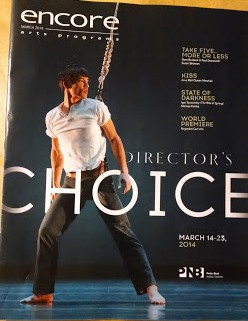In one episode of the Curious George cartoon, the man in the yellow hat says, “Magnetism is my favorite invisible force!” My family loved that line and we’ve found a surprising number of opportunities to use it in real life. At the 2014 Director’s Choice program last weekend, Pacific Northwest Ballet made a convincing argument for some of the others – and I’m not talking about gravity.
Take Five
Susan Stroman’s “Take Five … More or Less,” a playful piece set to jazz by Dave Brubeck and Paul Desmond, opens with perennial bridesmaid, Yellow, alone and bored on the stage. She is joined by her Starburst-colored friends and too few nameless men, until sexy Purple, accompanied by alto sax, comes in and steals all the men. My daughter whispered, “She’s just like the Mean Girl!” She meant Cid Charisse from Singin’ in the Rain, and she was right. The piece has much in common with Singin’ in the Rain’s “Broadway Melody.” Both explore the creative process in a jazzy setting; Stroman’s emphasis is on the idea that when your job is creativity, you never really take a break, and all the best ideas come when you’re not looking. In the novel Ahab’s Wife, the protagonist spends many nights anxiously contemplating problems until, on the verge of sleep her thoughts lose their linear thread and become disjointed, floating like jetsam in the ether. “Take Five” allows its characters to explore and discover in that unstructured space. Enclosed in individual spotlights, everyone gets their 15 seconds, but in the end, like Gene Kelly’s hoofer, Yellow gets her day in the sun.
Kiss
I saw Susan Marshall’s pas de deux “Kiss” in 2006. At the time I found the dancers’ suspension from ropes limiting. At the time, I missed the activity of movement across the stage floor. This time, I was much more impressed with the grace of the dancer’s swinging movements and the way that suspension in harnesses allowed the dancers to move in planes not available to dancers on the floor. But.
The piece is described in the booklet:
… they move together, separate and return to one another in a series of gentle, sweeping movements that embody both the pleasure and torment of being in love.
and quotes an Oakland Tribune review:
… it captures in concrete dance terms the almost palpable feeling of swimming in love…
That wasn’t what I saw. Arvo Pärt’s minimal score and funereal chimes made the scene sinister. To me the ropes were too strong a presence to allow the dancers to fly like Chagall’s lovers. The dancers repeatedly pull away from each other, and are restrained by the ropes. They cling desperately, and the man (the fabulous James Moore on the day I attended) climbs desperately up the woman’s body. They separate, and she (Carla Körbes) begins to rise in graceful spirals; but he can’t survive alone and soon dangles lifeless in his harness, so she returns.
Swimming in love? I don’t think so. More like drowning in it.
“Kiss” feels sinister and destructive to me, but it is unquestionably beautiful. Like the savage garden of Anne Rice’s vampire Lestat, or the searing violence of black metal, “Kiss” captures our attraction to the dark.
State of Darkness
“State of Darkness” proves the premise of “Take Five…” Molissa Fenley’s solo evolved out of her warm up routine. It shares many characteristics with my favorite ballet of all time (“Mopey”): a single male dancer (on this day, Matthew Renko) in black tights on a bare stage with stark lighting and strident, abrasive music. In this case, the music is Stravinsky’s “Rite of Spring.” “State of Darkness” is interesting because it takes an iconic piece of music and tells a different story – at least on the surface. Fenley didn’t choreograph “spring.” She made a story about darkness, violence, and power. Which, on second thought, is often where renewal takes place.
I always remember the soft trills early in the song that evoke crocuses and thawing earth, but Stravinsky’s season is not so gentle. Winter doesn’t let go all at once, and when carnivores awake from hibernation, the sweet furry spring animals are just lunch. It’s a primal piece of music, and for some reason, I was reminded of the organic processes that formed our inorganic planet, the violent upheaval that threw up mountains and shaped continents in an age when rock was molten.
I could say so much more about “State of Darkness.” Like Paul Corley’s set at Airwaves 12, this piece set off bottle rockets in my brain and it will probably take a while to make sense from all the patterns.
Memory Glow
The final piece was a world premiere. “Memory Glow” by Alejandro Cerrudo was like a warm soak in the tub after being caught in the breakers of “State of Darkness.” Cerrudo’s dancers moved like windblown cherry blossoms inside a square frame of footlights and a segmented score comprising six completely separate songs. Bathed in concentric circles of light, the dancers swirled and eddied through the silences between the songs as smoothly as they moved within the music. Words like “elasticity” and “tensile strength” seemed more apt than “steps” and “gravity.” When dancers came together, they didn’t hold each other like partners, but seemed held together by surface tension like water molecules.





About the author